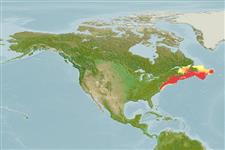Preferred temperature (Ref.
123201): 0.9 - 13.9, mean 7.3 °C (based on 497 cells).
Phylogenetic diversity index (Ref.
82804): PD
50 = 0.5000 [Uniqueness, from 0.5 = low to 2.0 = high].
Bayesian length-weight: a=0.00219 (0.00132 - 0.00363), b=3.22 (3.08 - 3.36), in cm total length, based on LWR estimates for this species & Genus-body shape (Ref.
93245).
Nivel trófico (Ref.
69278): 3.5 ±0.0 se; based on diet studies.
Generation time: 11.0 ( na - na) years. Estimated as median ln(3)/K based on 2
growth studies.
Resiliencia (Ref.
120179): Bajo, población duplicada en un tiempo mínimo de 4.5-14 años (Fec assumed to be <100).
Fishing Vulnerability (Ref.
59153): High to very high vulnerability (69 of 100).
Climate Vulnerability (Ref.
125649): High vulnerability (60 of 100).
Nutrients (Ref.
124155): Calcium = 4.1 [0.6, 75.0] mg/100g; Iron = 0.259 [0.025, 3.160] mg/100g; Protein = 15.8 [13.7, 17.8] %; Omega3 = 0.68 [0.28, 1.65] g/100g; Selenium = 19 [4, 97] μg/100g; VitaminA = 5.44 [0.42, 65.10] μg/100g; Zinc = 0.287 [0.020, 3.199] mg/100g (wet weight);
